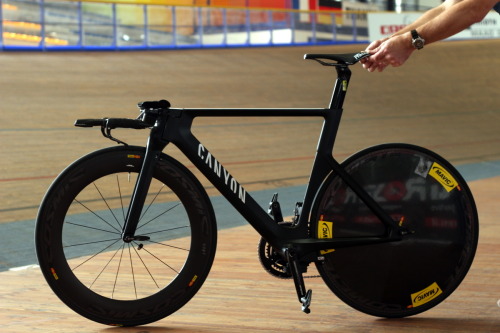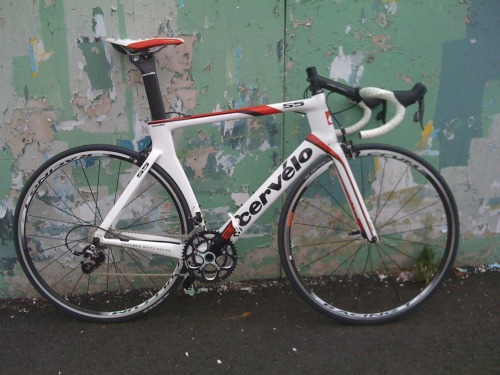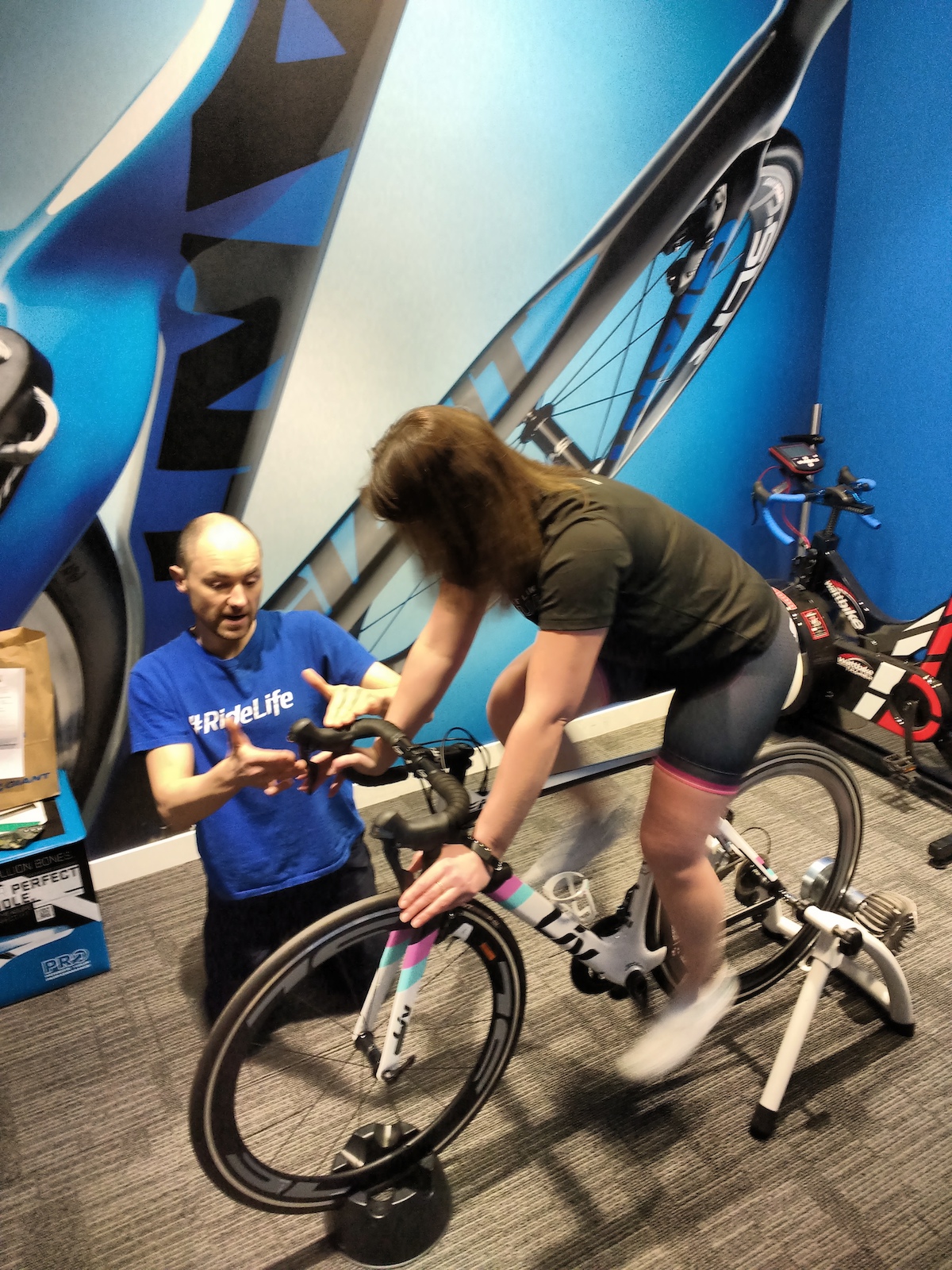- This topic has 50 replies, 26 voices, and was last updated 8 years ago by hooli.
-
How much steerer above stem is acceptable ? Road content !
-
iaincFull MemberPosted 8 years ago
Picked up new Defy yesterday and been playing with setup. I have an identical geometry 2012 one that I have until it’s new buyer picks it up on Sunday so have been setting new one up to match old, which fits and is comfy for long days.
Currently have 7.5mm of spacers above stem and there is no way I will be raising it. I might drop it another 2.5 or 5mm at some stage.
I can live with 5mm of spacers, 7.5mm looks a bit wrong…. LBS will chop it a bit for nowt as part of purchase…. Would you get a bit lopped off ?
scotroutesFull MemberPosted 8 years agoNah.
As you approach your dotage and become less flexible you might appreciate the chance to raise your stem.
wilburtFree MemberPosted 8 years agoYou can have whatever works for you bit beware too much can make for flexy handlebars.
DanWFree MemberPosted 8 years agoChop it all off…. When you live to regret it you could always pop on some VIAS aero risers and make an even worse looking front end than the original spacers 😉
Anything more than 5mm after dialling in fit looks a bit odd to me but there’s no reason to trim it reeeaaallly
downshepFull MemberPosted 8 years agoAt your age? Match the old one and cut the steerer to allow another 10mm of vertical adjustment as the years take their toll.
iaincFull MemberPosted 8 years agoDownshep – the steerer is about 4-6mm longer than old one in overall height and as you know I’m fitter and more flexible than when original was setup in 2012 bikefit…
tlrFull MemberPosted 8 years ago5mm.
Just in case you change stems and the steerer end is a different height.
brooessFree MemberPosted 8 years agoI have 10mm on mine. I might need to up it in a few years, or want to sell it. More than that looks daft IMO
scotroutesFull MemberPosted 8 years agoiainc – Member
Colin – this bike is my 50th birthday pressie to myselfI rest my case.
TiRedFull MemberPosted 8 years agoMy position is nailed down, but I haven’t seen the need to chop any of my Giant steerers. My medium Defy has half above and half below, the Propels are the same (they have quite long head tubes too). I have confirmed that there is insufficient to cause injury in a crash, and have just left them be.
I don’t think giant steerers are particularly generous to be honest.
But your new one is a disk fork, and oif the steerer is a lot longer, i’d chop it back to the same length as the old one.MerakFull MemberPosted 8 years agoNot read any of the above. None is the answer, not 5mm, not 3mm none, it’s none.
MerakFull MemberPosted 8 years agoStands corrected.
Rule #45 // Slam your stem.
A maximum stack height of 2cm is allowed below the stem and a single 5mm spacer must always – always – be stacked above. A “slammed down” stack height is preferable; meaning that the stem is positioned directly on the top race of the headsetcrashtestmonkeyFree MemberPosted 8 years agoIf it’s a decent bike it has a carbon steerer. In which case its usually recommended to have a spacer above the stem. So even if its slammed the answer isnt zero.
iaincFull MemberPosted 8 years agothanks, yes it’s a carbon steerer. I have 7.5mm above at present so will ride it a while. If I keep it where it is probably not chop, but if I drop it 2.5mm as I suspect I might then will get LBS to trim it so I only have 5mm above.
dirtyriderFree MemberPosted 8 years agohave a powerfit at Giant?
I’m picking up my Defy on Friday 11th and a fit was part of the purchase price
kerleyFree MemberPosted 8 years ago5mm.
Just in case you change stems and the steerer end is a different height.
Agree, this has caught me out a few times as I like to have no spacer above the stem but almost ran out of room when changing stems and have no spacers at all under stem now to just make it fit.
bikebouyFree MemberPosted 8 years ago5mm below the stem, 0 (zero) above it.
I’m a protagonist of the “slam” but only if you’ve got your position dialled in, and has been for at least 2-3 years.
eshershoreFree MemberPosted 8 years ago@iainc: do whatever is comfortable for your best riding position
antigeeFull MemberPosted 8 years agocrashtestmonkey – Member
If it’s a decent bike it has a carbon steerer. In which case its usually recommended to have a spacer above the stem. So even if its slammed the answer isnt zero.this I’ve always assumed to be correct because the upper stem bolt will have steerer inside it to tighten on to – otherwise relying mostly on the lower single bolt
assuming the steerer is a couple of mm short of the cap as is the normTrekEX8Free MemberPosted 8 years agoPresumably, if you put way too many spacers above the stem, you could be tightening the stem bolts/lower bolt below the level of the fork bung thingummy? Probably not good if the steerer is carbon fibre. Depending on how long the bung is, of course.***
***I actually haven’t got a clue.FrankensteinFree MemberPosted 8 years agoWait for a few weeks until you’re happy with your ride position.
Then chop but consider one spacer if you ever buy another stem that compulsory requires it like some carbon stems out there.
gravity-slaveFree MemberPosted 8 years agoI always leave a few mm steerer above the stem. This gives maximum contact area for stem/steerer clamping and ensures maximum stiffness and grip.
Steerer bung does not affect it, I have a carbon steerer and acros headset, which has no bung or traditional topcap.
iaincFull MemberPosted 8 years agohad a wee ride and will leave as is at 7.5mm – I could almost get away with 5mm above, rather than a 5mm and a 2.5mm, as it probably actually needs a 6mm one 🙂 but with just a 5mm, the top cap must be within 1mm of the plug I think.
DanWFree MemberPosted 8 years agoSlightly OT…. But if anyone has had the Powerfit service with Giant, would you be able to let me know what you thought and maybe even share a copy of the report? I like the idea of starting on the Wattbike but would also be curious how they measure up your new bike as this is usually the iffy step for me… Feel fine fitted on a static bike then everything doesn’t quite feel the same when the measurements get transferred to my own bike
wilburtFree MemberPosted 8 years agore flex handlebars:
Perhaps saying the bars flex was a poor description.
IME a longer steerer especially carbon ones are liable to flex more than a short one, its a simple principle but can be minimised by getting bar height you want by inverting the stem rather than having a clamped higher and angled down.
eshershoreFree MemberPosted 8 years agothere are issues with the Wattbike in terms of Q-Factor, replicating reach/stack and accuracy of X-Y measurements. I believe there is an X-Y tool with laser measurement coming at some point in the future.
We do all our ‘Powerfit’ OTB (on the client bike) with foot correction using Shimano custom footbeds (arch support) and BikeFit wedges for varus/valgus correction and BikeFit leg length correction shims if required. Cleat setup using ‘new neutral’ protocol for road cycling and forward protocol for triathlon and time trial. We spend a lot of time getting feet properly sorted before anything else.
Saddle selection is done using Pro’s saddle sizing system combined with rider feedback and flexibility assessment. We use laser projection grid with fluorescent dots, a good eye combined with basic tools like goniometer/plumbline for reference and smartphone camera very useful for checking position/capturing video for analysis.
Protocol is a modification of several existing systems including BG FIT. It’s what we call a good biomechanical bike fit with an emphasis on treating every rider as an individual rather than trying to ‘average’ every client.
DanWFree MemberPosted 8 years agoThank you very much for that. I didn’t realise Giant had a “fit” system in place and thought it was more Trek/ Spec. Certainly a nice service to be able to offer when buying a bike, rather than be limited to a few boutique fit places or one man and a camera type setups then wonder how on earth it relates to bikes you may be looking at. Nice to have it linked in to the manufacturer which hopefully takes away from some of the uncertainties a little bit and reduces some variables
RustySpannerFull MemberPosted 8 years agoThe only certainty is that anyone using the phrase ‘slam the stem’ is a Muppet.
🙂eshershoreFree MemberPosted 8 years agoI should have pointed out that the fit I described was specific to the Docklands store. It’s what we call an ‘enhanced Powerfit’ in that we have brought our own elements to the system specifically foot correction (which benefits 80% of the population) and pelvic stability through saddle selection and setup
Other stores will follow a stock Powerfit protocol which is based around the Wattbike and uses an App on the I-Pad, with measurements then transferred to the client’s bike. The stock protocol does not deal with foot correction, which as any good fitter knows, is the basic building block of a good bike fit – it will also ask a fitter to “average” length leg for saddle height which is not ideal (rather than dealing with functional or physical leg length discrepancy during the foot correction element).
Giant manufacture the Wattbike in Taiwan for the Wattbike company, and their Powerfit was a development of this partnership. There are limitations, and its still in its infancy as a system, hence some stores enhancing the fit with other elements and using a different protocol.
If you study other systems like Retul and BG Fit, they have years of development and large amounts of $$$ invested to get where they are today.
Retul is particularly interesting in that Specialized purchased a majority shareholding and have integrated some of the tool set into BG Fit. Retul is a protocol but many fitters use the motion capture system as a digital toolset / tape measure in conjunction with their own experience and a modified protocol.
DanWFree MemberPosted 8 years agoThat is super interesting info, thanks. Particularly wrt Giant having an involvement with Wattbike and Specialized having a share in Retul.
Any idea what Trek do? It looks like a 2D video based system despite attaching reflective markers and calling it “motion capture”.
As an aside it always bugs me that Retul gets referred to as a 3D fit as the kit can in theory measure “3D” but gets used as a series of 2D measurements (side 1, side 2, front). Same outcome as a video camera despite using more sophisticated technology, but I guess it automates things somewhat for the fitter and speeds up the session (extracting angles etc).
Have you come across any other bike companies getting behind their own fitting besides Spec, Trek, Giant?
It is also good to hear that most places are taking the initiative to modify the various protocols rather than follow something blindly.
Sorry for going off topic OP, but it is just so interesting to learn more about bike fitting 🙂
eshershoreFree MemberPosted 8 years agoYes the 3d thing is misleading.. It’s what called x-y-z with z being the frontal plane. BG fit was one of the first to specifically target z plane for knee tracking and pelvic stability.
All of the systems have limitations and advantage/disadvantage. The most important element is the bike fitter, and this is where prepackaged systems can fail – the quality of training, assessment, certification based on skill, experience and manner rather than automatic pass because you attended a course. Willingness to learn, listen and constantly assess is important.
Unusual clients are a challenge and a unique learning experience. Last week I fitted a world class Ironman triathlete who’d had a history of injury and surgery.
Right side 30 degrees, left side 20 degrees, functional leg length difference very noticeable, I built a considerable leg length stack under the left cleat. Pelvis stable under high load, excess ankling eliminated.
Found this very interesting and satisfying to assist a client.
iaincFull MemberPosted 8 years agowell it’s all setup and feels comfy. Will hold off getting it chopped for now I think.
The topic ‘How much steerer above stem is acceptable ? Road content !’ is closed to new replies.






